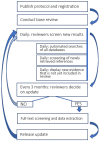The impact of the COVID-19 pandemic on self-harm and suicidal behaviour: update of living systematic review
- PMID: 33604025
- PMCID: PMC7871358
- DOI: 10.12688/f1000research.25522.2
The impact of the COVID-19 pandemic on self-harm and suicidal behaviour: update of living systematic review
Abstract
Background: The COVID-19 pandemic has caused considerable morbidity, mortality and disruption to people's lives around the world. There are concerns that rates of suicide and suicidal behaviour may rise during and in its aftermath. Our living systematic review synthesises findings from emerging literature on incidence and prevalence of suicidal behaviour as well as suicide prevention efforts in relation to COVID-19, with this iteration synthesising relevant evidence up to 19 th October 2020. Method: Automated daily searches feed into a web-based database with screening and data extraction functionalities. Eligibility criteria include incidence/prevalence of suicidal behaviour, exposure-outcome relationships and effects of interventions in relation to the COVID-19 pandemic. Outcomes of interest are suicide, self-harm or attempted suicide and suicidal thoughts. No restrictions are placed on language or study type, except for single-person case reports. We exclude one-off cross-sectional studies without either pre-pandemic measures or comparisons of COVID-19 positive vs. unaffected individuals. Results: Searches identified 6,226 articles. Seventy-eight articles met our inclusion criteria. We identified a further 64 relevant cross-sectional studies that did not meet our revised inclusion criteria. Thirty-four articles were not peer-reviewed (e.g. research letters, pre-prints). All articles were based on observational studies. There was no consistent evidence of a rise in suicide but many studies noted adverse economic effects were evolving. There was evidence of a rise in community distress, fall in hospital presentation for suicidal behaviour and early evidence of an increased frequency of suicidal thoughts in those who had become infected with COVID-19. Conclusions: Research evidence of the impact of COVID-19 on suicidal behaviour is accumulating rapidly. This living review provides a regular synthesis of the most up-to-date research evidence to guide public health and clinical policy to mitigate the impact of COVID-19 on suicide risk as the longer term impacts of the pandemic on suicide risk are researched.
Keywords: COVID-19; Living systematic review; Self-harm; Suicidal thoughts; Suicide; Attempted suicide.
Copyright: © 2021 John A et al.
Conflict of interest statement
Competing interests: DG: member of the Department of Health and Social Care (England) National Suicide Prevention Strategy Advisory Group. DG has grants from the National Institute for Health Research (NIHR) outside the submitted work and is a member of Samaritans Policy and Research Committee and Movember’s Global Advisory Committee. AJ: chair of the National Advisory Group on Suicide and Self-harm Prevention to Welsh Government and is national lead on suicide prevention for Public Health Wales. She reports grants from Medical Research Council (MRC) and MQ KH: member of the Department of Health and Social Care (England) National Suicide Prevention Strategy Advisory Group. He reports grants for DHSC and the Global Challenges Research Fund. NK: member of the Department of Health and Social Care (England) National Suicide Prevention Strategy Advisory Group and sits on committees for the National Institute for Health and Care Excellence to develop clinical guidelines for depression and self-harm. He reports grants outside the submitted work from NIHR, DHSC, and the Health Care Quality Improvement Partnership.
Figures




References
Publication types
MeSH terms
Grants and funding
LinkOut - more resources
Full Text Sources
Medical
Miscellaneous

